
In the third of our YourStreet articles, Ben is taking us on a historical ride along the Alton Towers Railway.
In the second part of his article, we are going to be taken on a guided tour around the railway’s engine and rolling stock shed so we get to know the locomotives which worked on the railway over its 52 year existence.
‘Altonia’ – Baguley Engineers Ltd. Works Number 1769
It was on the 16th May 1929 when a diminutive locomotive rolled out of the workshops of Baguley Engineers Ltd. Works number 1769, she had been ordered on the 8th February 1929 and was the first of a new design of ‘steam outline’ locomotive to be built for 2 foot gauge railways. She was destined for the Lillishall Abbey Woodland Railway (LAWR), which had opened a year previously, and would become that line’s primary motive power for ten years. Amusingly, in the 1983 Alton Towers park map, the locomotive was being described as being built for ‘local quarry work’, which I am sure that the owners of the LAWR wouldn’t have been too pleased at! As a result of the outbreak of war in 1939 services were ceased on the LAWR and both 1769 and her earlier cousin Baguley works number 1695 were put into store.
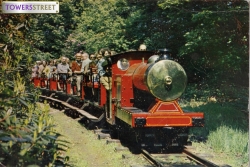 Both locomotives remained hidden until 1952, when the operating company of a new railway within the grounds of Alton Towers were looking to acquire a locomotive of their own. Upon inspecting the two locomotives in store, they chose the newer and more powerful 1769 which was then sent to the reformed EE Baguley for a thorough overhaul. 1695 was destined to remain in store at Lilleshall Hall (the railway having been lifted) until its move to the Cadeby Light Railway in 1967.
Both locomotives remained hidden until 1952, when the operating company of a new railway within the grounds of Alton Towers were looking to acquire a locomotive of their own. Upon inspecting the two locomotives in store, they chose the newer and more powerful 1769 which was then sent to the reformed EE Baguley for a thorough overhaul. 1695 was destined to remain in store at Lilleshall Hall (the railway having been lifted) until its move to the Cadeby Light Railway in 1967.
Arriving at Alton Towers in March 1953, 1769 was now sporting a smart new maroon and yellow livery, a big change from the ‘Brunswick Green’ it carried on the LAWR. She would go on to handle passenger services at Alton Towers for the majority of the railway’s forty-three year life with overhauls to keep her running well.
It was in the late 1960’s that Denis Bagshaw, the managing director of Alton Towers Ltd. bestowed Bg 1796 with the name ‘Altonia’. This name was painted in a scroll on the tanks underneath a lion holding the Alton Towers crest, which seemed to follow the pattern of Alton Towers logos in the 1960s.
Towards the end of the railway’s life, Altonia was modified for two track operation through the fitting of a ‘deadman’ foot pedal and through braking, presumably a requirement to satisfy the growing requirement for strict health and safety in the park. After services were stopped at the end of the 1996 season, Altonia was left hidden, but still on the railway, only being run backwards and forwards occasionally to keep her in working order for a possible reopening . This revival never happened and eventually she was moved off track and was sold into the hands of a private collector in 2002, disappearing into store in Surrey for the second time in her seventy year life. Similarly to her situation at Alton Towers, Altonia was occasionally moved around to keep her in working order.
But this wasn’t the end for Altonia. In September 2010 she was offered for sale at an auction in Derby, with estimates valuing her at around £20,000. These estimates were never realised and she was to remain in store until being offered to the Old Kiln Railway on an ‘indefinite loan’ in August 2012. This move reunited her with two of original Alton Towers coaches and after a break of fifteen years, she is now back running occasional ‘Alton Towers Specials’ on the ½ mile line in Surrey.
‘Golspie’ / ‘The Trentham Express’ – E.E. Baguley Ltd. Works Number 2085
Golspie was built by EE Baguley in 1935 for the 2 foot gauge railway at Trentham Gardens. She was ordered to replace the underpowered locomotive Brora which was another member of Baguley’s ‘1769’ class and therefore a sister to Altonia. To ensure that Golspie had ample power in order to operate the line at Trentham she was rebuilt in 1961 with a larger engine and three speed gearbox. The locomotive carried a deep red livery and continued to run in this guise until the site was transferred to the ownership of John Broome in the early 1980s.
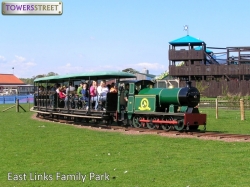 John Broome, who already was a majority stakeholder in Alton Towers, had grand plans for Trentham Gardens. The railway continued to run after the takeover, however locomotive 2085 lost the name Golspie, being renamed Trentham Express instead. After the disposal of the leasehold by John Broome, the railway was then wound up by the new owner and Trentham Express and sister Trentham Flyer were moved to Alton Towers for storage with the view of an eventual transfer to Broome’s other site at Battersea Power Station.
John Broome, who already was a majority stakeholder in Alton Towers, had grand plans for Trentham Gardens. The railway continued to run after the takeover, however locomotive 2085 lost the name Golspie, being renamed Trentham Express instead. After the disposal of the leasehold by John Broome, the railway was then wound up by the new owner and Trentham Express and sister Trentham Flyer were moved to Alton Towers for storage with the view of an eventual transfer to Broome’s other site at Battersea Power Station.
Again, these plans were not to come to fruition and The Trentham Express was to remain derelict and in store. She never ran at Alton Towers and was eventually moved to the Amerton Railway at the start of the new millennium where she took on her original name of Golspie. The scale of the work required on Golspie meant that other projects took priority over her. This wasn’t to be the end however, as in early 2013 a small group began working and on the 24th April 2013 the engine was successfully started for the first time. The group are now working on the gearbox with a view to an eventual return to passenger service.
‘Dunrobin’ / ‘The Trentham Flyer’ – E.E. Baguley Ltd. Works Number 3014
Dunrobin was the final locomotive acquired for the Trentham Gardens line. Delivered in 1938, she was delivered to Trentham as an 0-6-0 (meaning she had an extra pair of wheels than both Brora and Golspie) and was turned out in a matching livery to Golspie. The arrival of a second locomotive (and the subsequent upgrading of Brora) allowed for two train operation which continued after 1961 when Dunrobin received a brand new 60hp Perkins engine.
To fit in with the naming wishes of John Broome, Dunrobin was renamed the Trentham Flyer and it was in this guise in which after closure of the railway at Trentham it went into store at Alton Towers. Unlike the Trentham Express, the Trentham Flyer was to see service at Alton Towers which was now owned by the Tussauds Group. As was documented earlier, the railway at Alton Towers was rebuilt into two independent lines and it was for this set up that the Trentham Flyer was overhauled at Beech Engineering services in 1992, returning in March 1993.
For the operation of the railway at Alton Towers, 3014 was fitted with through braking systems, a ‘deadmans’ foot pedal and a new Perkins engine. She was turned out in British Racing Green with a similar Alton Towers crest painted on the tank sides to Altonia. Although several names were considered for the scroll under the crest, 3014 ultimately remained nameless at Alton Towers. With the closure of the Alton Towers line in 1997, 3014 was parked out of sight next to Altonia and run occasionally in order to keep her in running order.
3014 was to move onto its third, and current, home at in 2000 when the East Links Family Park came looking for a locomotive to power their ‘Safari Train’. With a deal successfully negotiated 3014 and four coaches departed for their new railway in Scotland. Entering service in the same livery, albeit with a large East Links Family Park ‘The Express’ logo replacing the Alton Towers crest, she has continued to offer a passenger service around the park to many happy families.
‘John’ – Barnes Atlantic 103
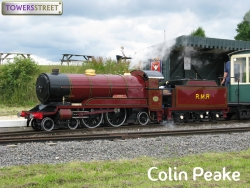 The only steam locomotive to run on the Alton Towers Railway was Barnes Atlantic #103 John. Designed by Henry Greenly, she was built in 1922 by Albert Barnes for the Rhyl Miniature Railway in north east Wales. Just before the closure of the line at Rhyl, John was overhauled and prepared for sale. It didn’t take long for the locomotive to catch the eye of John Broome, who moved it to Alton Towers in 1978. Here, it was planned that she would share the workload with Altonia which was made possible by laying a third rail to cater for John’s gauge of 15 inches which was different to the 24 inch/2 foot gauge of Altonia. Unfortunately, this third rail only extended for just under 100 yards and ‘John’ was only ever seen in light steam pottering around the Ingestre station. When the line was shortened at the beginning of the theme park era, John remained in the original station, cut off from the rest of the line. This set up offered no further opportunities for her to stretch her legs and eventually she was sold to the Whorlton Lido Railway in 1985. She stayed here until 1991, when she moved to her second theme park home at Lightwater Valley in Yorkshire. Unlike Alton Towers, the line at Lightwater was built to 15 inch gauge and therefore John was able to be used on passenger services until being sold into private hands in 1996. She then made infrequent appearances at the Ravenglass and Eskdale Railway in Cumbria before being sold on to Helen and Jim Shackell in 2000.’John’ was then fully overhauled and ran on the Evesham Vale Light Railway until that line changed hands in 2012. The locomotive is currently (2013) in private hands.
The only steam locomotive to run on the Alton Towers Railway was Barnes Atlantic #103 John. Designed by Henry Greenly, she was built in 1922 by Albert Barnes for the Rhyl Miniature Railway in north east Wales. Just before the closure of the line at Rhyl, John was overhauled and prepared for sale. It didn’t take long for the locomotive to catch the eye of John Broome, who moved it to Alton Towers in 1978. Here, it was planned that she would share the workload with Altonia which was made possible by laying a third rail to cater for John’s gauge of 15 inches which was different to the 24 inch/2 foot gauge of Altonia. Unfortunately, this third rail only extended for just under 100 yards and ‘John’ was only ever seen in light steam pottering around the Ingestre station. When the line was shortened at the beginning of the theme park era, John remained in the original station, cut off from the rest of the line. This set up offered no further opportunities for her to stretch her legs and eventually she was sold to the Whorlton Lido Railway in 1985. She stayed here until 1991, when she moved to her second theme park home at Lightwater Valley in Yorkshire. Unlike Alton Towers, the line at Lightwater was built to 15 inch gauge and therefore John was able to be used on passenger services until being sold into private hands in 1996. She then made infrequent appearances at the Ravenglass and Eskdale Railway in Cumbria before being sold on to Helen and Jim Shackell in 2000.’John’ was then fully overhauled and ran on the Evesham Vale Light Railway until that line changed hands in 2012. The locomotive is currently (2013) in private hands.
Rolling Stock
As with the locomotives, all of the rolling stock used on the Alton Towers Railway was Baguley equipment which was acquired from other 2 foot gauge railways. The first six coaches, which were obtained from the Lilleshall Abbey Woodland Railway, were simple four wheel coaches with bench style seats. Before arriving on the railway, the coaches were rebuilt into the common ‘toastrack’ style through the addition of bench style seats. These gave passengers the option to travel forwards or backwards as opposed to the side on seating employed at Lilleshall. These coaches ran on the railway from opening until the end of 1992 with very little changes. With the exception of one brake carriage, this set was un-braked with drivers using the locomotive’s brake to slow a moving train.
With the acquisition of eight coaches in a package which also included locomotives 2085 and 3014 and a greater emphasis on safety, it was in 1992 that a decision was taken to replace the aging four wheel coaches. As was mentioned earlier, the railway was double tracked for the start of the 1993 season and six of the eight overhauled bogie coaches were marshalled into two rakes of three coaches for use on this new setup. These sets were fitted with full braking systems which met the standards set by the Railways Inspectors and also had overall roofs which undoubtedly kept visitors happy! These overhauled bogie coaches ran on the line until closure in 1996.
As for current locations – all but three coaches are currently based on operating railways. The original Lilleshall 4-wheel set was initially sold to Alan Keef Ltd. In 1993 who then dispersed them far and wide. Two coaches made their way to the Old Kiln Light Railway in Surrey where the ex-brake coach was fitted with a roof. One coach went to the Launceston Railway in Cornwall where it was converted into an inspection trolley which can move under its own power – The Dilly. The final three coaches went to the town of Roosky in Ireland where they ran for a few more years until going into store when the local railway was closed and lifted.
The Trentham bogie coaches are far easier to trace as four of them went with locomotive 3014 and now operate the East Links ‘Safari Train’. Rather less glamorously, the remaining four coaches were stripped of their bodies and the under frames are now at the East Hayling Light Railway in Hampshire where they have been fitted with new coach bodies to that railway’s standard design.
Conclusion
The railway at Alton Towers was one of the early attractions which started the ‘Amusement Park Era’. In its early days it offered visitors a leisurely railway journey from the main hub of the park through the woods and into the park’s famous gardens. This purpose developed over the years with a greater emphasis on transporting larger amounts of people to the new ‘Theme Park’ zones of Gloomy Wood and Forbidden Valley which were located on the opposite side of the gardens. Sadly, the greater emphasis on health and safety combined with high staffing levels and competition from the Skyride meant that the railway was no longer a viable attraction for Alton Towers to operate. After closure many hoped that the railway could be revived, however these hopes were dashed when the ‘Haunted Hollow’ was constructed along the route of the railway.
It is unlikely that we will ever hear the ‘clickety clack’ of railway tracks at Alton Towers again. Fortunately for enthusiasts however this isn’t the end of the story if you know where to look. Three of the four locomotives to have been involved with Alton Towers are currently operating on railways around the British Isles and if you are lucky you might even get to ride in a restored carriage. If this happens, close your eyes and imagine you are passing through the wooded gardens of the historic Alton Towers.
References
Scott, P (1998), Minor Railway Histories: A history of the Alton Towers Railway, Reading: Peter Scott
The above book is the ultimate guide to the Alton Towers Railway – Unfortunately now out of print, if a second hand copy comes up on Amazon – it would come very highly recommended.
Scott, P (2002), Minor Railway Histories: A history of the Wicksteed Park Railway, Reading: Peter Scott
Weaver, R. (1975), Baguley Locomotives: 1914-31, London: Industrial Railway Society
Alton Towers (1957), Alton Towers Official Guide, Derby: Tresises Ltd.
Alton Towers (1961), Alton Towers Souvenir Guide Book, Nottingham: Ruddocks Advertising Ltd.
Alton Towers (1964), Alton Towers Souvenir Guide Book, Nottingham: Ruddocks Advertising Ltd.
Alton Towers (1967), Alton Towers Souvenir Guide Book, Nottingham: Ruddocks Advertising Ltd.
Alton Towers (1970), Alton Towers, Birmingham: Brandwood
Dixon, J.A. (No Date), Alton Towers, Staffordshire, The Miniature Railway [Photograph], Date Viewed: 28th August 2013.
Various Park Maps since 1980.
Images from – Matt Bentley, Tim Dunn, Colin Peake and East Links Family Park


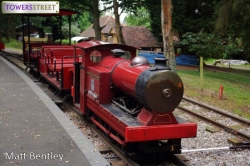
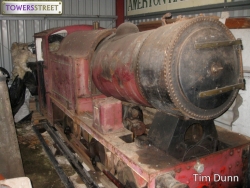
 Ben is interested in both the historical side and the more modern developments that occur at Alton Towers. His interests include narrow gauge railways and playing football.
Ben is interested in both the historical side and the more modern developments that occur at Alton Towers. His interests include narrow gauge railways and playing football.